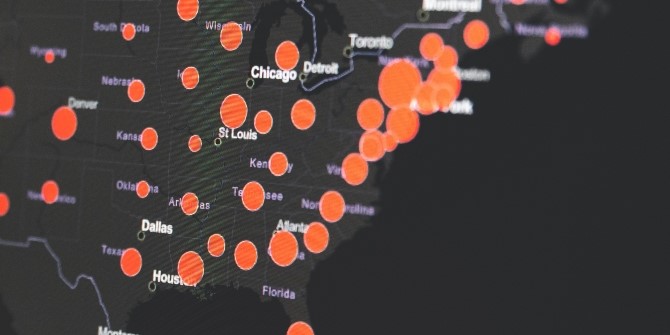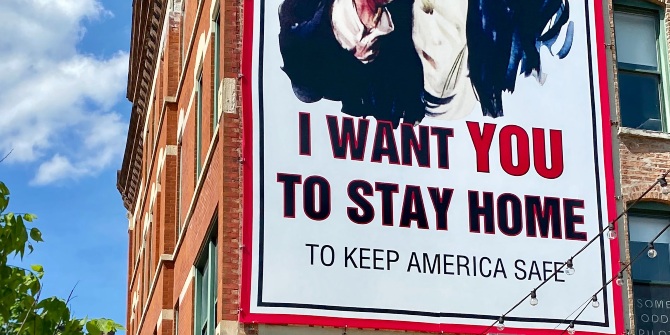
 In the opening weeks of the COVID-19 pandemic, 90 percent of the US population were under a Stay-at-Home Order across 42 states. Susan M. Murray and Gregg R. Murray examine the factors which may have influenced state governors in issuing COVID-19 related Stay-at-Home Orders. They find that medically related scientific factors were only mildly related to the issuing of COVID-19 Stay-at-Home Orders. Compared to protecting public health, the timing of the initial orders and states’ political and economic conditions were much more important in governors’ decision-making.
In the opening weeks of the COVID-19 pandemic, 90 percent of the US population were under a Stay-at-Home Order across 42 states. Susan M. Murray and Gregg R. Murray examine the factors which may have influenced state governors in issuing COVID-19 related Stay-at-Home Orders. They find that medically related scientific factors were only mildly related to the issuing of COVID-19 Stay-at-Home Orders. Compared to protecting public health, the timing of the initial orders and states’ political and economic conditions were much more important in governors’ decision-making.
What went into US governors’ decisions to issue stay-at-home orders (SAHOs) in response to the first wave of the COVID-19 pandemic? Mandating social distancing is a powerful tool for fighting the spread of infectious diseases. But depriving people of their freedom of movement – the practical effect of issuing a SAHO – is a profoundly consequential decision. The social and economic costs to society are tremendous, not to mention harms to fundamental rights such as freedom of assembly and the free exercise of religion. Governors are fully aware of the potential electoral costs they may pay for imposing a severe disruption on voters. It is reasonable to expect that taking measures to stop the spread of a large-scale, easily transmissible, and demonstrably lethal disease would be the primary driver of decisions during this time of crisis. This is particularly the case for a disease like COVID-19 of which initially little was understood as infection spread quickly and hospitalization and death rates spiked. But how does protecting people from a widespread and urgent health threat weigh against political, social, economic, and other factors traditionally expected to influence public policy?
Beginning with the first confirmed death due to COVID-19 on US soil in February 2020, the governors of all 50 states declared states of emergency over the following 17 days. Restrictions on public gatherings and school closures closely followed. Increasing levels of restrictions culminated with the most severe – stay-at-home orders – eventually declared by the governors of 42 states starting with California on March 19 and ending with South Carolina on April 7. Though the governors of Arkansas, Iowa, Nebraska, North Dakota, Oklahoma, South Dakota, Utah, and Wyoming did not issue blanket statewide SAHOs, 90 percent of the US population was impacted.
Public health motivations were only mildly related to COVID-19 Stay-at-Home Orders
One might expect policies made in response to a major public health crisis to be motivated primarily by medically related scientific factors such as population vulnerability and state medical capacity. For example, older adults or people with serious underlying medical conditions would be more vulnerable to the disease. So, a governor may be more concerned or more willing to issue a SAHO if their state had more elderly or unhealthy residents. Despite the large range in percentage of population age 65 or over in US states (11 to almost 21 percent) and early knowledge that the elderly and chronically ill were more at risk, our analyses indicate that state health vulnerabilities, like older age, do not appear to have impacted governors’ decisions to issue a SAHO.
Perhaps more direct medical concerns were at the top of governors’ minds? A governor may have been particularly concerned if the disease was threatening to overwhelm the state’s medical capacity, which may lead the governor to attempt to flatten the pandemic curve by declaring a SAHO to slow the spread of infection. COVID-19 deaths or cases per intensive care unit, per regular hospital bed, or per medical doctor, each scaled for state population, could reasonably be expected to impact governors’ decisions, and we found that this was indeed the case. A governor was a statistically significant one-tenth of a percentage point more likely to issue a SAHO on any given day with the report of an additional death per bed per 10,000 population.
State economies and politics and COVID-19 Stay-at-Home Orders
So, if the policy response to the pandemic was somewhat mildly impacted by medically related scientific factors, what did substantively impact governors’ decisions? We also looked at factors that are typically associated with public policies in general. We included social, economic, and political factors, as well as measurements of how policies diffuse, both geographically and over time.
Though we expected SAHOs to be more palatable in states with more focus on civic mindedness versus individual autonomy, we did not find this social context to be related.
We expected governors in states with stronger economies – those with lower unemployment or better bond ratings – might think their states would be better able to bear the burden of a temporary shut-down making them more likely to issue an order. However, we found the opposite. Governors of states with strong economies were less likely to issue a SAHO. Each one-percentage-point increase in unemployment, which ranged from 2.4 to 6.1 percent, increased the probability of issuing a SAHO on any given day by a statistically significant 1.5 percentage point.

Photo by Cole Freeman on Unsplash
The next area of consideration is politics. Responses to public health crises were politically polarized even before the coronavirus pandemic. Reactions to the 2009 H1N1 virus (swine flu) broke strongly along party lines, and we expected the same in the case of COVID-19 SAHOs. The political party of the governor and the political party of the electorate both appear to have been factors in governors’ decisions to issue an order. All 24 Democratic governors issued orders, while 69 percent of Republican governors did. Perhaps both were influenced by the Republican president Trump’s limited response but in opposite ways. Democratic governors were a statistically significant 2.5 percentage points more likely to issue a SAHO on any given day. And each one-percentage-point increase in Democratic vote share of the electorate, which ranged from 24 to 67 percent, is associated with a statistically significant two-tenths of a percentage point increase in probability an order would be issued.
Last, we considered how these policies may or may not diffuse geographically or over time. Geographically, we expected a governor to be more likely to issue a SAHO if neighboring states issued one. The neighboring governor may give political cover for the difficult decision or to protect against the physical spread of the disease across state boundaries as neighboring cases presumably accelerated. Conversely, a governor may want to keep their economy open to attract business from states that have closed. Regardless, we found only the weakest of support for a positive effect for geographic diffusion.
Past research has found that policies diffuse over time by beginning slowly with early adopters, accelerating as other states learn from early adopters, and then tapering off as laggard states are slow to adopt or to not adopt at all. This S-shaped curve pattern appears in the adoption of a wide range of policies, as well as technologies and other innovations. And this pattern powerfully held true regarding COVID-19 SAHOs.
Time and politics were more important than medical factors
So, medically related scientific factors played something of a role in governors’ decisions to issue COVID-19-related SAHOs. But how do these medical considerations fare against other considerations? Looking at standardized marginal effects, time-based diffusion played the largest role, with eight times the effect of scientific considerations. Political factors were the next most important, having three to five times the effect, while economic considerations had three times the effect. Scientific considerations did have more effect than the social factor, which appears not to have been impactful at all.
We offer evidence about how political leaders prioritized medically related science in their responses to the COVID-19 pandemic. These decisions suggest science was a low priority relative to external diffusion as well as political and economic factors. One might expect that protecting public health would be the primary factor in decisions during an acute health crisis. But in a democracy, in which politicians are electorally accountable, it should not be surprising that at times they represent their constituents as delegates and not trustees, for scientific good or bad.
- This article is based on the paper ‘“Following the Science? Examining the Issuance of Stay-At-Home Orders Related to COVID-19 by US Governors,” in American Politics Research.
- Please read our comments policy before commenting.
- Note: This article gives the views of the author, and not the position of USAPP – American Politics and Policy, nor the London School of Economics.
- Shortened URL for this post: https://bit.ly/3R9gPI8






